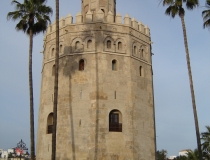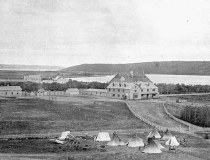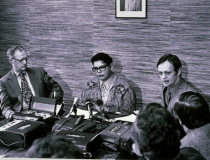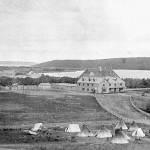
Gold and the Americas
Gold and the Americas – El Torre del Or – the Golden Tower in Seville – symbolises one the main motivations for the Spanish and European conquest of the Americas – the search for gold and other riches. In my novel, Eaglechild, there is a scene in Seville involving Rupert, the 13 year-old son of María Concepción, a Spanish Countess, and Miguel, Rupert’s young Jesuit tutor who is working on his doctoral thesis about the Spanish Conquest of the Americas.
They decided that a good starting-point was the discovery of the New World by Christopher Columbus in 1492. The most memorable fact about it, from Rupert’s point of view, was that Columbus had taken his thirteen-year-old son with him on one of his voyages of discovery
“He was so lucky,” said Rupert, referring to the boy.
“He probably said the same about the children in your family – his father wanted a noble title so badly. Columbus liked to make friends with noble families like yours in the hope they would put in a good word for him at the royal court. Of course, your ancestors wanted something from him, too – they wanted gold and profit from his discoveries in the Americas.”
On their first walking tutorial, Miguel took Rupert to the twelve-sided Golden Tower on the banks of the Guadalquivir River. They climbed its winding staircase to the top and took in the view it offered of the river and the city.
“It’s hard to believe, isn’t it, that this tower was here about two hundred years before Columbus set sail.” Miguel was looking south, downriver. “It would have been the last major monument to the Old World that he would have seen before he left for the New World and the first when he returned.”
“But he sailed from Palos.” Rupert had learned this from geography classes at Summer Meadows.
“ Yes, he did, on the first voyage. But he sailed there from here. And he put things together in Seville, got his first permissions from the royal court here and most of his money.”
“It was like a lighthouse, wasn’t it?” asked Rupert referring to the Golden Tower. “It was covered in gold and shone in the sunlight.” He was repeating a local legend.
“That’s a nice idea. But if gold on its walls reflected in the sun, it would have been the golden colour in its Moorish tiles. I like the other theory better – that it got its name when it was converted into a warehouse for the gold that arrived from the Americas. There were huge quantities. That’s why they set up royal mints in Seville – to turn the gold into coins and medals soon after it arrived.”
“How did we find so much gold, Miguel?”
“Well, it wasn’t we who found it, to be accurate. The Indians found it. We gave them trade goods for it – knives and cloth and so on. But if the truth were to be told, much of the first gold to be sent back here was confiscated from the Indians – in other words we stole it. I’m afraid we also took most of their gold ornaments and works of art and religious statues and vessels and melted them all down – very little survived. Your mother has a few pieces, and there are some in museums. But we have archaeologists to thank for recovering most of them. And after we took their gold, we seized their gold mines and opened new mines, too, and put the Indians to work in them as our slaves.”











